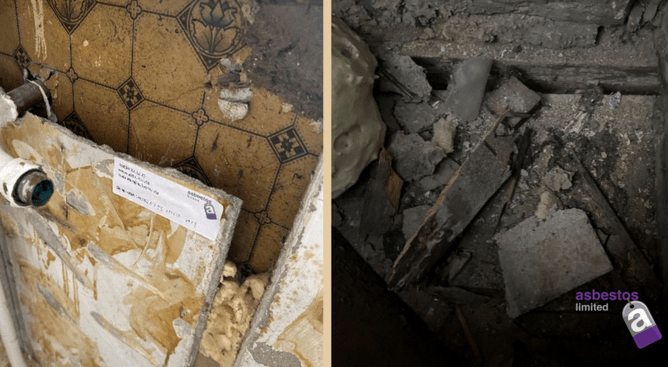Sadly this is where things can start to go wrong as obviously people want the lowest cost for the highest return, but the above are actually 2 different services.
We were recently called by a contractor regarding a potential risk in a bathroom they were refurbishing. There was concern about some paneling to the walls, so a sample was requested. Whilst we asked if a survey was required, the contractor said just the sample of the panel, but could we also check the ceiling during our visit. We attended site and were a little shocked that work had started, but took a sample of the paneling and also cross referenced that sample to some debris in the floor void as they were visually similar. The ceiling was plasterboard, so no sample was taken.
"What else is lurking?" asks contractor
The sample returned a positive result and the panels were identified as Amosite and Chrysotile containing asbestos cement. The problem is that the contractor is now concerned about what else may be in the area they are working in, so the client has paid for a sample when what they actually needed was a pre-refurb (pre being the operative word here…) survey. The survey would have answered this question and many others, so the client has incurred the cost of a sampling visit in addition to the survey cost. With proper planning, this would have been avoided and the money for the sampling visit would have been saved.
Does this item contain asbestos?
When asked to take a sample of a suspect material, the person calling has decided that they need the answer to a simple question, “Does this item contain asbestos?”. The report following a sampling visit will simply confirm the presence or absence of asbestos in the sample that was sent for analysis.
A documented process
A survey of a specified area, or whole building, is not the same. The surveyor will methodically check the area for potential Asbestos Containing Materials (ACMs) and they will decide what needs to be sampled. This decision is based on training and experience and follows a documented process (The Survey Guide HSG264 section 5).
If you are working on a pre-2000 building, whether commercial or domestic, there is the potential for ACMs to be present and it is a requirement that a pre-refurbishment survey (section 51 of HSG264) is carried out, PRIOR TO PLANNING/STARTING WORK.
Essentially, if you have decided what to sample, you need to be able to prove your competency for the role of making that decision. If the building is being well managed and an item has accidental damage that reveals additional materials, requiring a sample to be taken to decide a course of action, this service can be what you need.
But, if you are planning work that disturbs the fabric of a building you need a qualified, competent, experienced asbestos surveyor to carry out an asbestos survey PRIOR TO PLANNING/STARTING WORK! It really is far more cost effective, as not only do you save on the sampling visit, you can also plan any remediation work that is required, rather than, “Oops, found another bit, need to shake that money tree again and again…”.
Live asbestos management plan
For commercial buildings, any results, whether positive or negative, should be added to your live asbestos management plan (AMP). When we say commercial, this includes revenue producing residences (section 60 of HSG264) so a management plan could also be required for domestic properties.
Our offer - a free compliance check list
We are offering a free compliance check list to help with asbestos management, so if you feel this would help you find any gaps in how your properties are managed, please email management@asbestos.ltd and we will help you to fill those gaps to get you compliant.

